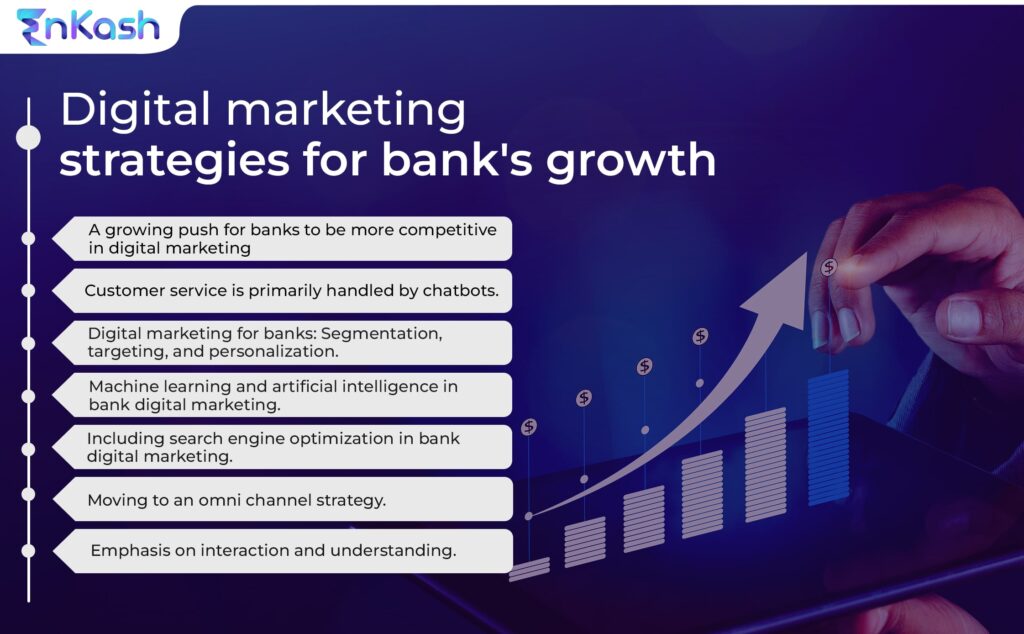How Digital Marketing can Add to Banks’ Growth Strategies?
Digital marketing is becoming increasingly important for banks and today accounts for nearly half of all marketing expenses. Many mid and small-sized banks and financial institutions have difficulty keeping up with digital marketing trends in banking, and are seen lagging behind larger banks who have larger resources.
Digital marketing strategies typically involve paid advertisements as a substantial proportion of the overall marketing spend. However, emerging trends in digital marketing for banks emphasize other factors like personalization of customer experience, better customer outreach, and improved audience segmentation to focus on the quality of advertising.
There are numerous considerations to weigh in when planning a digital marketing campaign and the following six digital marketing trends in banking are among the most significant.

1. Competition pushing banks to swiftly adopt digital marketing for growth
Nearly every bank today has a digital presence and advertises across platforms, from social media to video to PPC ads on Google and Bing. To improve the efficiency of their advertising, most banks believe they need to raise their digital marketing budget and efforts.
While increased competition in the banking business demonstrates the value of digital marketing, it also makes it more difficult to distinguish one from the other. In today’s highly competitive digital marketing world, this means banks must adopt distinctive tactics, putting customers at the forefront. Banks need to provide value through marketing services, and use non-conventional awareness campaigns rather than standard commercials to drive the most interactions with customers.
2. Customer service is primarily handled by chatbots.
With increasing availability, complexity, and sophistication of alternatives for digital marketing tools and strategies for banks, chatbots are one of the fastest growing components of any customer service. Customers want quick and frequent responses without having to pick up the phone and dial. Customers can ask questions and receive assistance with minimal effort using chatbots in banking that connect with social media, websites, and applications.
Chatbots are among the most appropriate tools to digitally address typical customer queries, account checks, service checks, and screening via the first rung of customer assistance and similar banking services.
- Also Read: Potential of Digital Payments
3. Segmentation, Targeting, and Personalization
Big data enables banks to not only improve digital marketing strategies but also target individual customers rather than entire segments, resulting in better personalization and an integrated user experience. Single-person segmentation here usually relies on tracking via cookies and other modern methods. Digital marketing tools aggregate and gather data across Omni channel touch points including the web, social media, and apps to enable complete customer engagement and enhance overall customer experience.
4. Machine Learning and Artificial Intelligence in Bank digital marketing
In banking, Artificial Intelligence and Machine Learning are crucial components in integrating applications, chatbots, and single-person segmentation. These approaches are also essential on their own. Machine learning is a terrific approach to take advantage of the large datasets that most banks have access to.
For instance, AI may track a user’s journey across a website, social media, and apps, including in their search (via cookies), and create a customized user experience for them. AI can show customers relevant products or services, refer them to a customer support professional if necessary, and predict what they need based on their actions and behavior.
5. Including Search Engine Optimization in Bank digital marketing
While keyword research has mostly remained unchanged for the past few years, new search-based marketing approaches are beginning to gain traction. Marketing content must now be completely adapted to appear in mobile searches, voice searches, and occasionally in a combination of both. It’s critical to customize content marketing strategies and keywords to satisfy those objectives while avoiding interfering with the user’s experience.
Banks must tweak alter their digital marketing strategies and content sharing methods to provide brief and concise answers for mobile and voice search consumers as a result of this bank marketing trend.
6. Moving to an omni channel Strategy
Before visiting a branch or opening an account, most customers will learn about a bank through several channels, such as social media and a website. Some people will also download and test the app first. Adapting to this omni channel experience entails curating a customer journey across platforms so that customers are exposed to consistent branding and a near-seamless experience.
You can also use cookies to track where your consumers come from, which can enable you to adapt the user experience and match their requirements.
7. Emphasis on interaction and understanding
Many digital marketing trends focus on accepting and leveraging new technologies, but clients are also expecting more from banks. Banks must provide more with 24-hour service, the opportunity to easily switch banks, and the ability to compare what banks offer on a detailed level. Customer experience should have something extra. Automation, artificial intelligence (AI), and pattern recognition can all help consumers get better deals, avoid missing out on key information, provide value, and improve their overall experience.
Although digital marketing trends in banks are always changing, several things remain consistent year after year. For example, all banks should put in place a strong digital presence and provide an app to cater to the needs of younger customers while also providing ease to everyone. To improve user satisfaction, most companies should focus on providing a better customer experience, with more personalization and adaptive services. The incorporation of these components into digital ads will also aid in the fight against growing internet competition.
We can agree digital marketing strategy is an integrated approach to online marketing.
The Bottom Line
Most banks currently have the technology and data necessary to implement a digital marketing strategy for banks. What is lacking is the capacity to focus on digital marketing, construct a strong online strategy, and design and manage online marketing initiatives. This implies fewer possibilities to engage with consumers looking for services and fewer opportunities to strengthen connections with current clients. Our six suggestions are excellent first steps toward utilizing available resources to develop powerful digital marketing campaigns for banks.
Begin by examining where you’ve been, where you are, and where you need to go next within the framework of your chosen strategic digital development manifesto proclamation. Create a strategic plan that includes up to three specific action items that you can commit to taking action on and moving forward with as you progress from excellent to outstanding.
To know more, visit: www.enkash.com. You can also click below on Signup Now and we will reach out to you soon.









